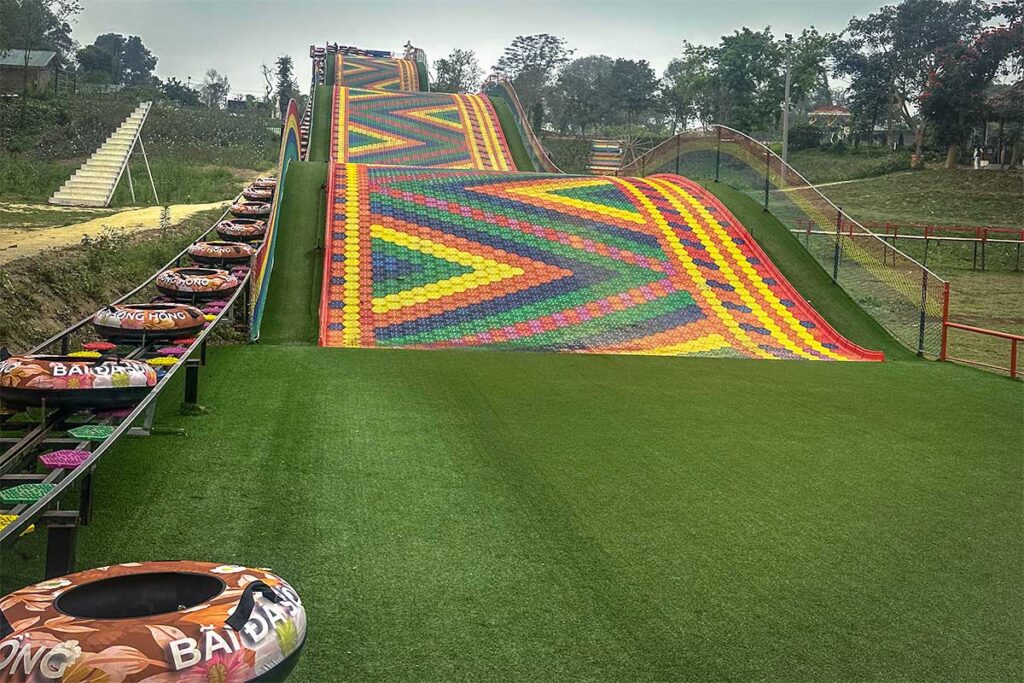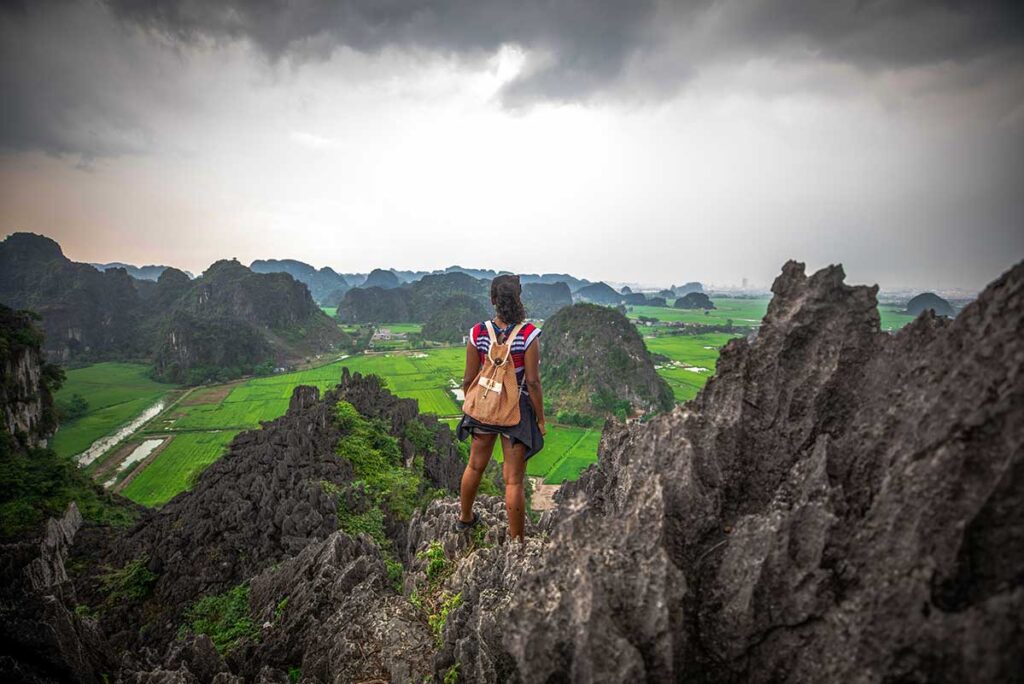What is the Hanoi Rainbow Slide?
Viral Sensation on TikTok and Instagram
The Hanoi Rainbow Slide first gained attention through short viral videos on TikTok and Instagram. Most clips show visitors zipping down a long, colorful slope on inflatable tubes, often filmed with a GoPro for extra drama.
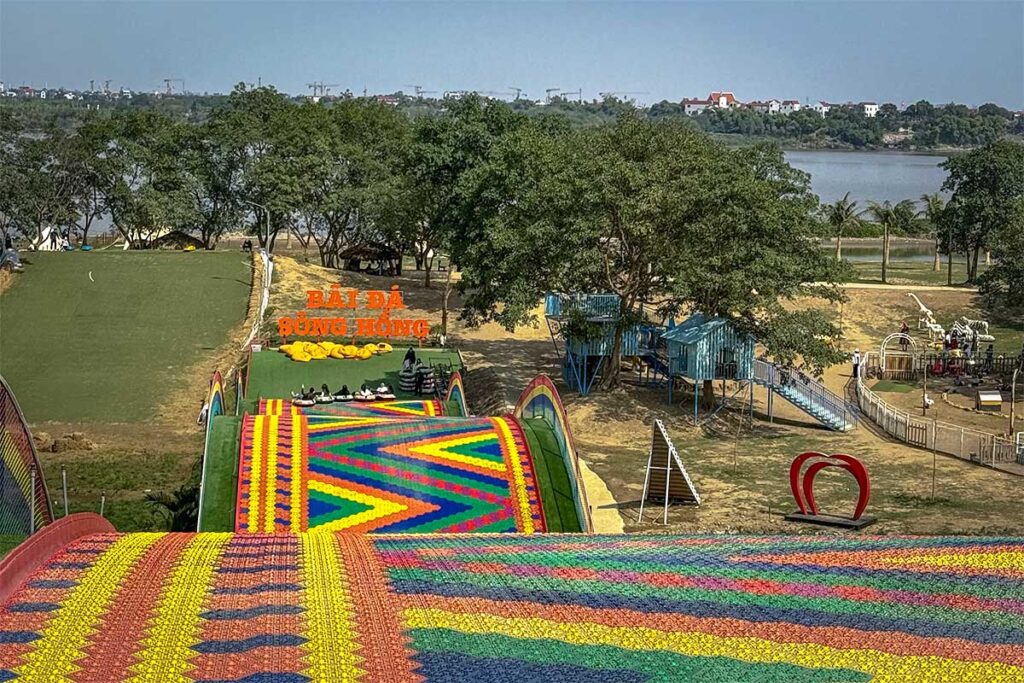
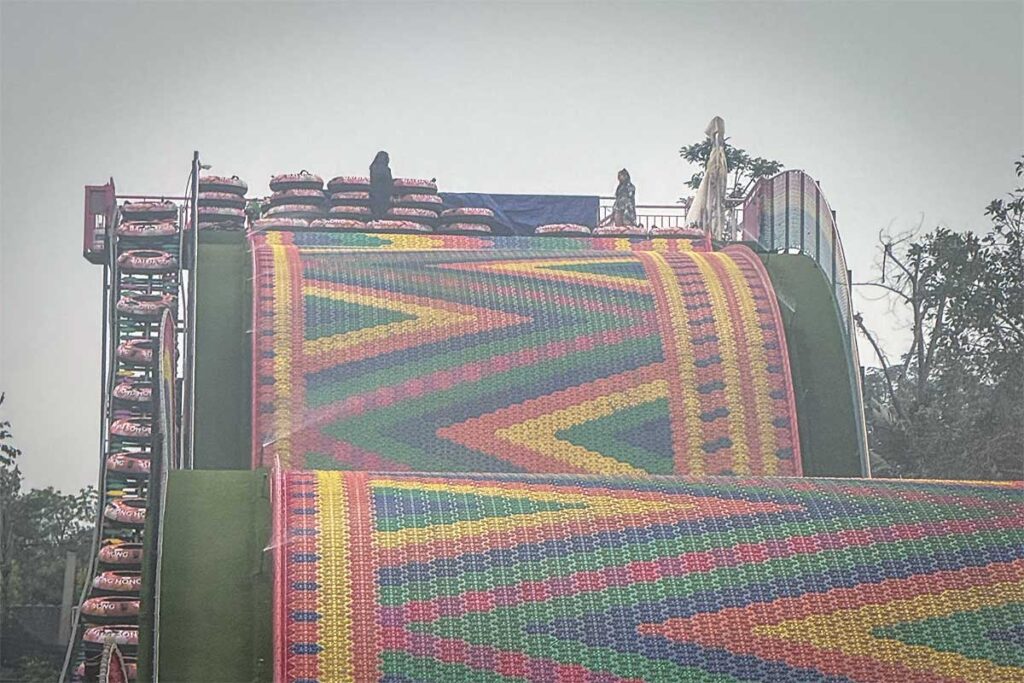
What makes it stand out is the speed — riders often lift slightly off the surface near the bottom, adding a surprising thrill to what looks like a kids’ attraction. It quickly became one of those “must-try once” things that spread among curious travelers and local content creators.
Part of Bai Da Song Hong (Song Hong Flower Garden)
Despite the amusement-park-style ride, the Rainbow Slide isn’t part of a full-scale theme park. Instead, it’s tucked inside Bai Da Song Hong, a large outdoor garden area along the Red River. Originally developed for domestic tourism, this area is built around Vietnam’s “check-in culture” — where people visit for staged photo zones, decorative flower fields, and quirky props designed for social media pictures.
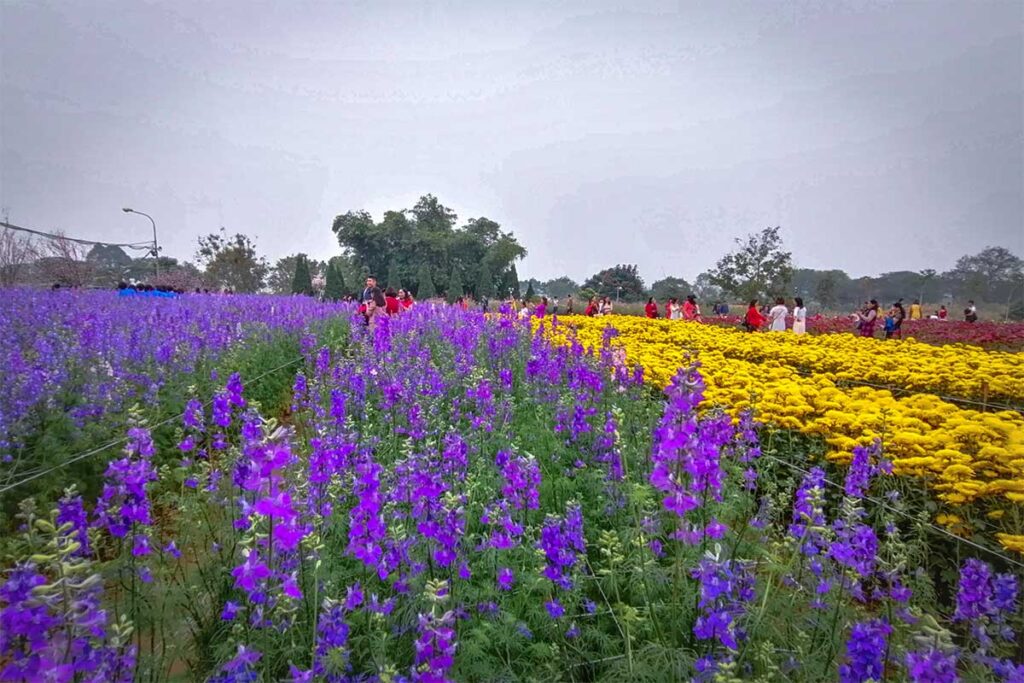
You’ll find swings, small bridges, heart-shaped tunnels, flower-covered walls, and even rentable costumes — all meant to create the perfect backdrop for photos. While that appeals to local visitors, most foreign tourists wouldn’t go out of their way for this alone. The slide, however, has become the one standout attraction that crosses over into international interest — offering a bit of lighthearted fun in an otherwise kitschy setting.
Things to do at Bai Da Song Hong
1. Rainbow Slide (Main Highlight)
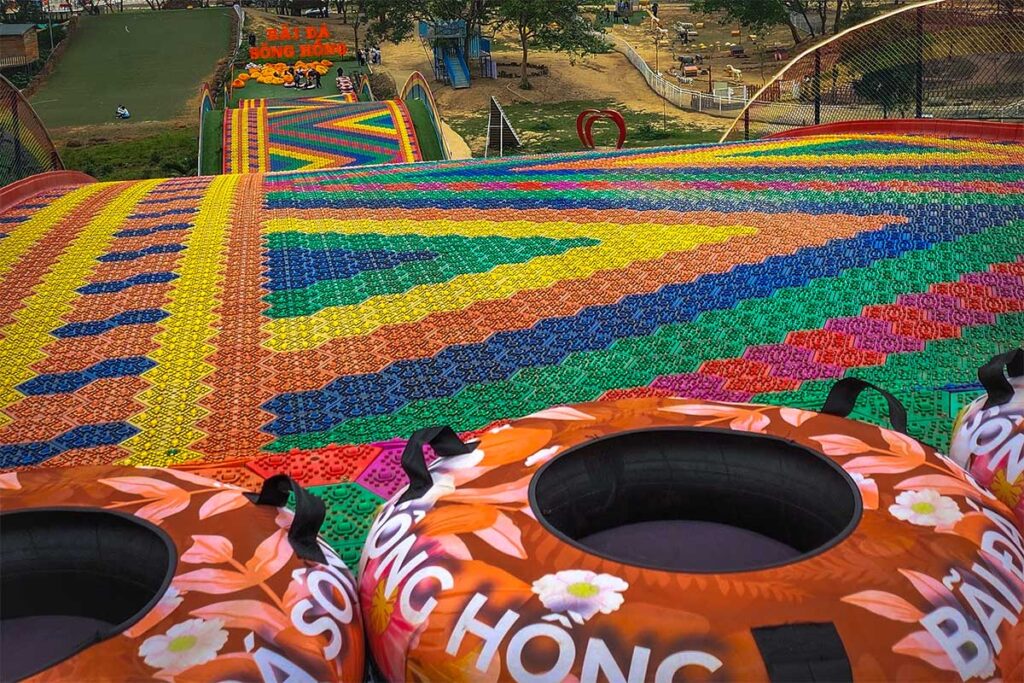
The Rainbow Slide is by far the biggest draw — and the reason most international visitors come here. You sit on an inflatable tube and slide down a long, rainbow-colored slope that picks up more speed than expected. Many riders describe “catching air” near the end, especially if you go all the way without braking.
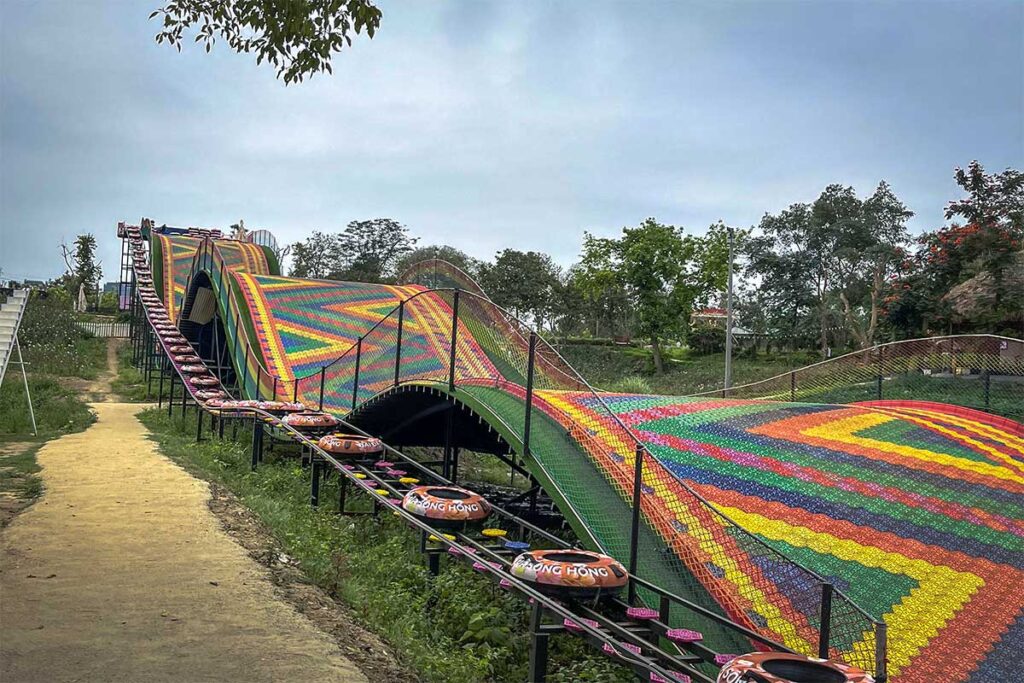
A single ride costs around 50,000 VND, paid separately from the entrance fee, and lasts just a few seconds — but it’s a fun, adrenaline-boosted moment. Staff near the bottom are usually happy to take a video for you if you ask.
2. Kayaking by the River
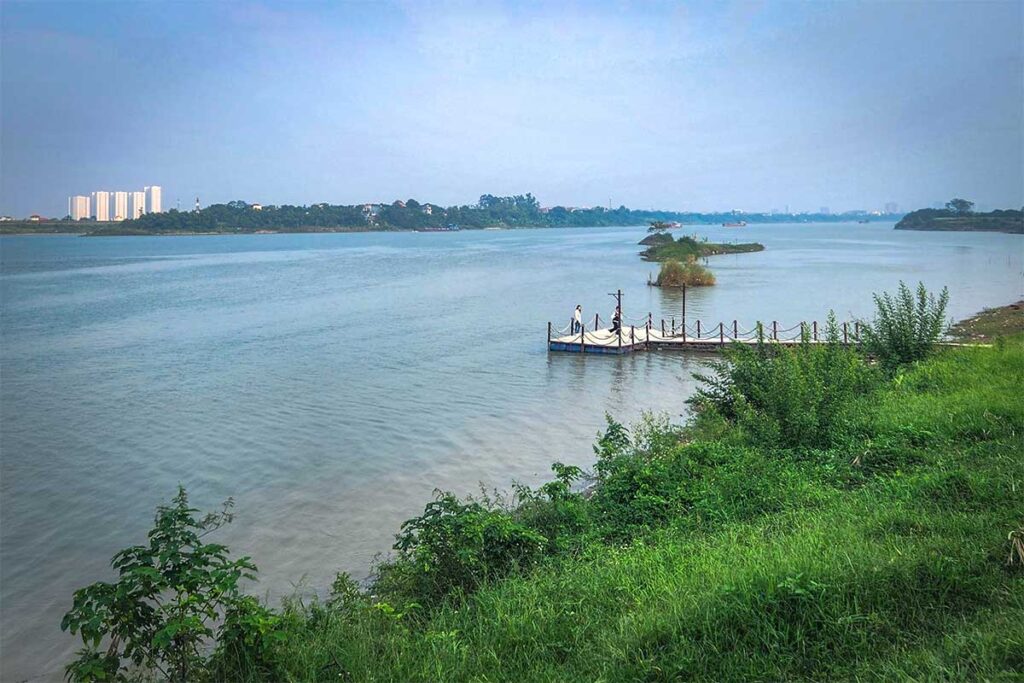
You can also rent a kayak and paddle along a calm section of the nearby Red River. It’s a short, gentle ride — not a full adventure — but can be a peaceful break from the busier photo zones. Water levels and cleanliness vary depending on the season, but on clear days it’s a scenic detour.
3. Flower Gardens & Selfie Zones
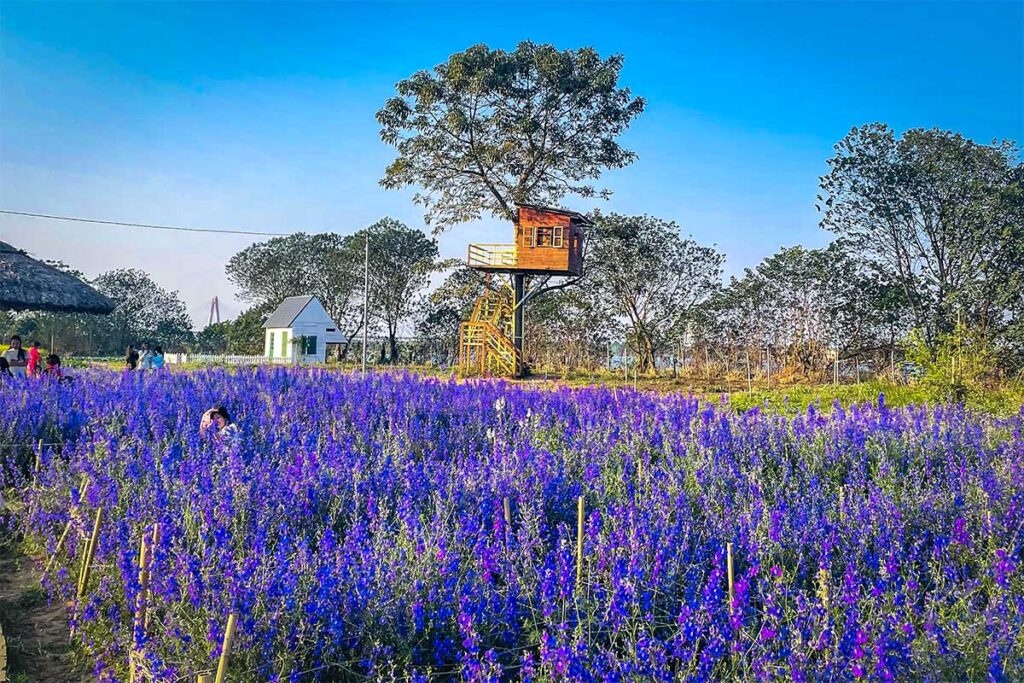
Flower fields are everywhere here, planted with seasonal blooms like cúc họa mi (daisy-like flowers) in winter, sunflowers in summer, and rows of artificial cherry blossoms in low season. You’ll find decorative bridges, wooden swings, animal statues, heart-shaped archways, and other props made for check-in photos. While some areas feel tacky or overdone, the morning light can make everything look better — especially if you come with low expectations and a camera-ready mindset.
4. Animal Area
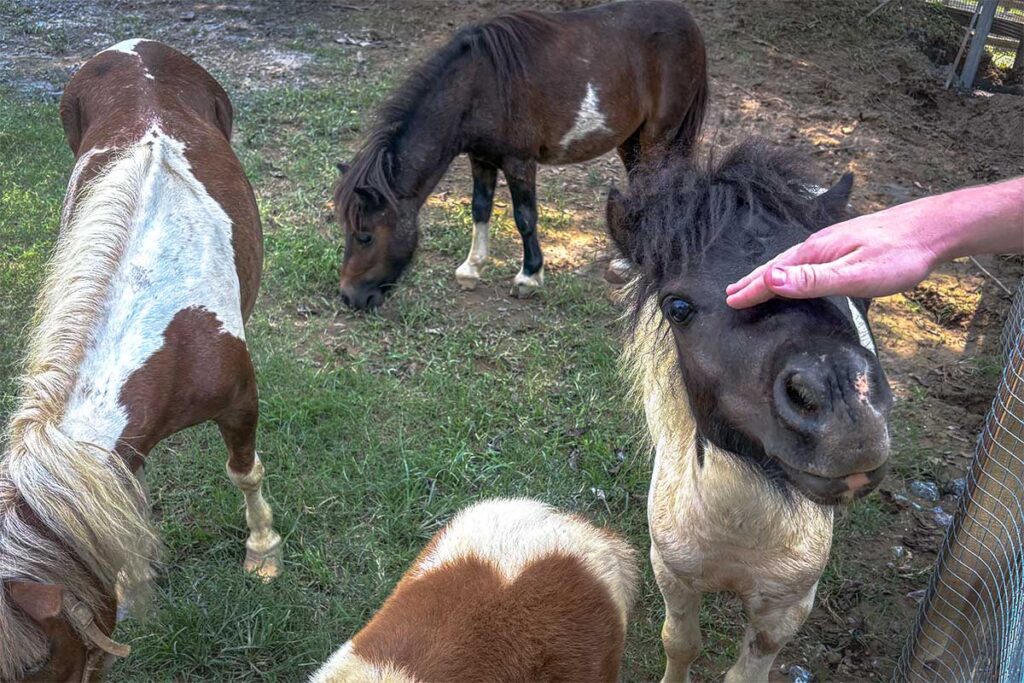
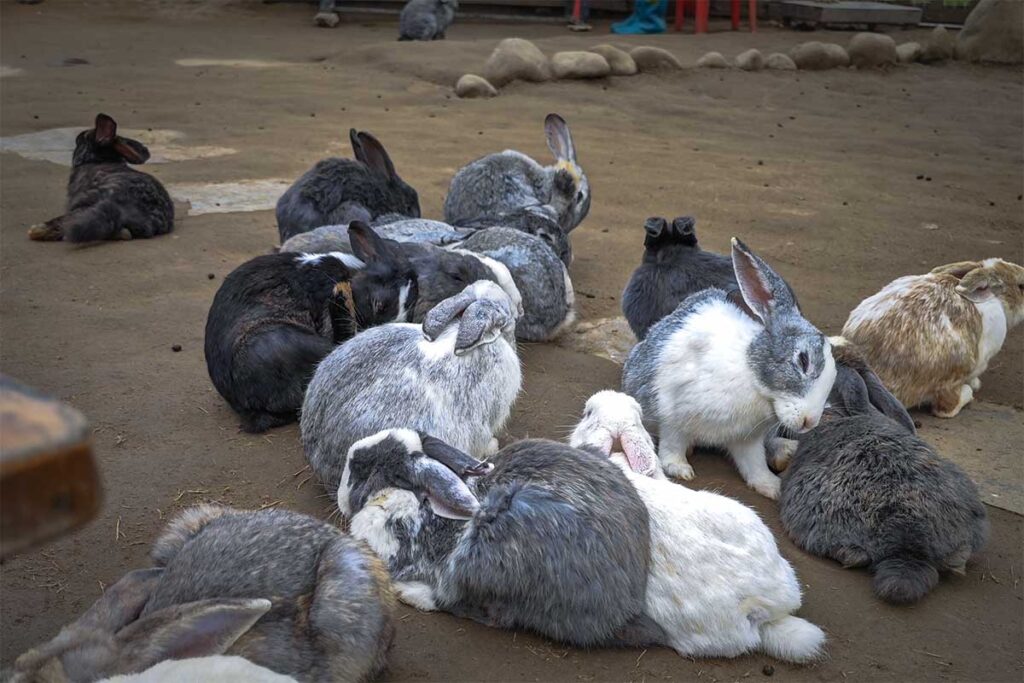
The small animal enclosures feature sheep, goats, rabbits, and sometimes dogs or ponies. You can buy food to feed them for 10,000–20,000 VND. However, many reviews mention poor animal welfare, including tied-up horses, dirty pens, and no visible water or shade. If you’re sensitive to these issues, it’s best to skip this part — it’s not well maintained and feels more like a photo zone than a petting area.
5. Go-Karts and Arcade Games
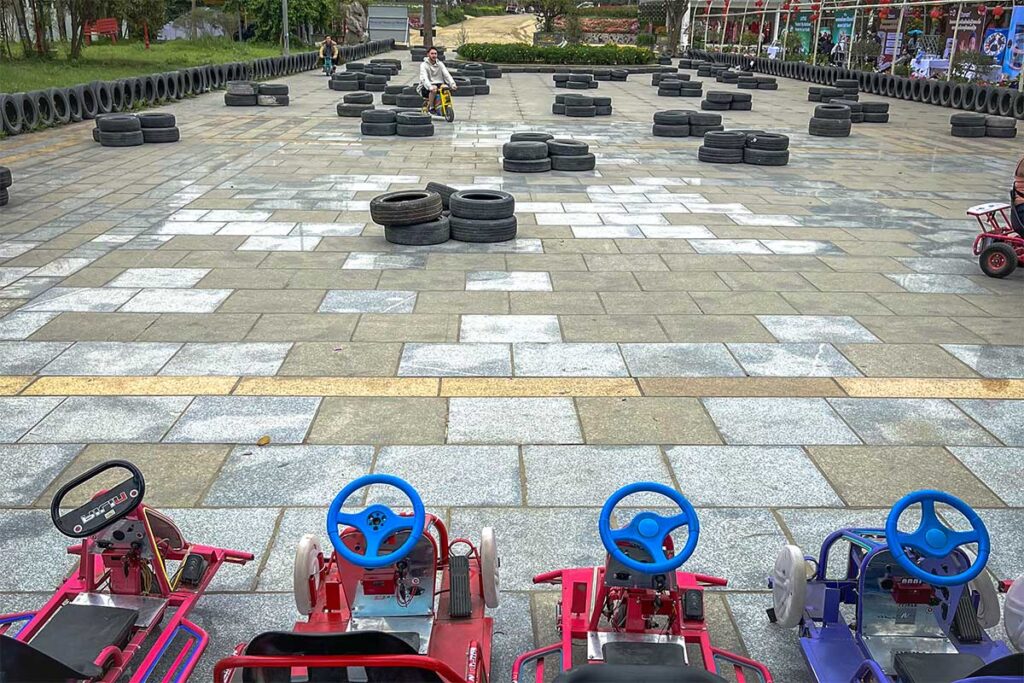
There’s a small outdoor go-kart track — not very fast, but fun for kids or groups. Next to it is a tiny indoor arcade with a few claw machines and simple video games. Don’t expect much here, but it can be a quick add-on if you’re already nearby.
6. Costume Rentals & Photo Services
One of the more popular domestic experiences here is renting traditional costumes like Vietnamese áo dài or even Korean-style hanbok, usually for around 100,000 VND. These are meant for posed photos in the flower fields or selfie zones. While it’s not something most foreign travelers do, it adds to the check-in culture vibe of the place. You’ll also find small photo studios offering full packages — makeup, props, and a photographer — but these services are mainly geared toward local couples and groups.
7. Chimi Farm (Strawberry Garden)
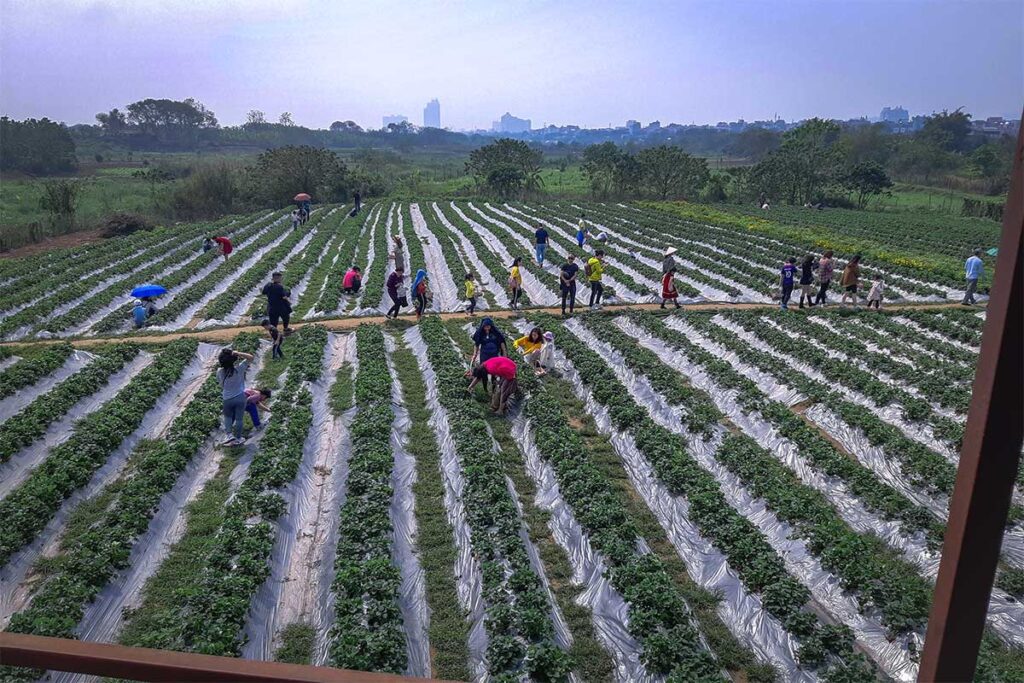
Chimi Farm sits next to the flower garden and offers a pick-your-own strawberry experience. While it’s mainly aimed at local families, international visitors can still enjoy a short walk through the rows or grab a juice or smoothie made from fresh fruit. Entry is around 70,000 VND, and strawberries are sold separately by the basket. It’s a cute detour if you’re already in the area, but not a must-see.
8. Picnic & Camping Areas
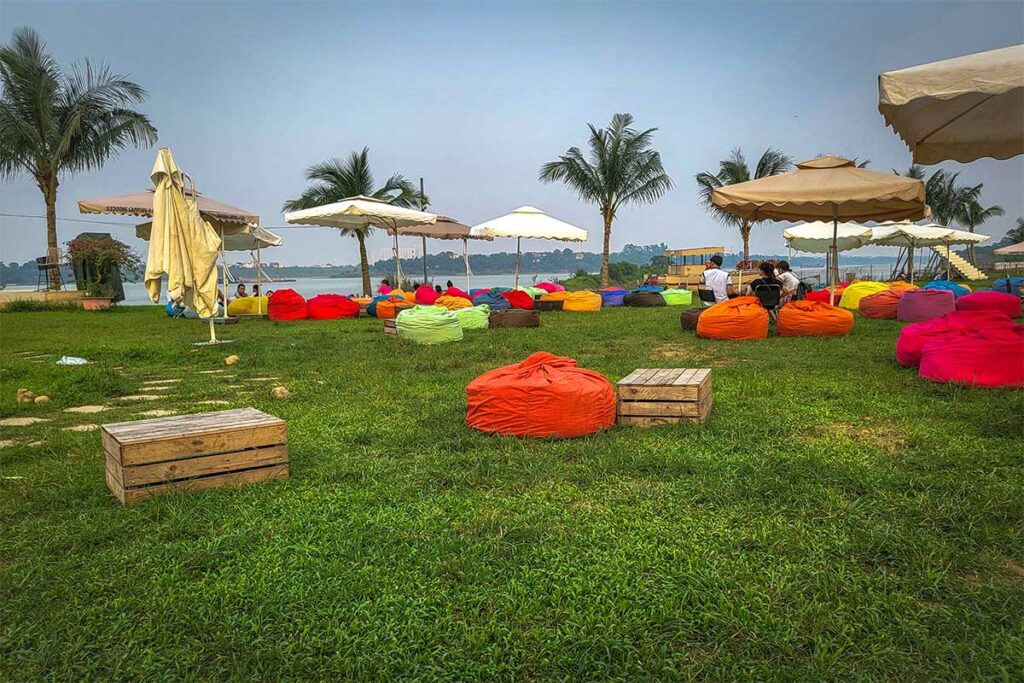
There’s a designated picnic and “day camping” area with rented tents and low tables — something that appeals mainly to local families or groups of friends looking for a casual weekend hangout. It’s not the kind of camping most foreign travelers would seek out, and there’s no overnight option. Still, it’s part of the domestic draw of the place, and you may see groups barbecuing or sitting under umbrellas if you visit on a busy day.
9. Food & Drinks
There’s a simple food court with basic Vietnamese dishes — think bún chả, phở, grilled skewers, and drinks like sugarcane juice and coconut water. Prices are reasonable, but cleanliness and service are hit-or-miss depending on the day. For picky eaters or families, it might be better to bring snacks or eat before arriving.
Where is the Hanoi Rainbow Slide?
The Hanoi Rainbow Slide is tucked inside Bai Da Song Hong (also known as the Song Hong Flower Garden), in Tay Ho District, on the northern edge of West Lake. It sits close to the Red River embankment, about 7 to 8 kilometers from Hanoi’s Old Quarter — depending on traffic, the trip usually takes 20 to 30 minutes by car or motorbike.
Despite its viral fame, the exact location isn’t always easy to spot on Google Maps, and the entrance is hidden down a narrow side lane (ngõ 264 Âu Cơ). If you’re trying to search for it online, look for “Bãi đá sông Hồng” rather than the slide itself — most navigation apps still don’t list “Hanoi Rainbow Slide” as a place name.
How to get there
The easiest way to reach the Hanoi Rainbow Slide is by Grab or taxi, either by car or motorbike. From the Old Quarter, the ride typically takes 20–30 minutes, depending on traffic. Just enter “Bãi đá sông Hồng” into the app — it’s located at the end of ngõ 264 Âu Cơ in Tay Ho District.
If you’re on a budget and don’t mind a bit of walking, several local bus lines stop nearby, including 13, 31, 33, 41, 55, and 58. However, navigating the bus system in Hanoi can be confusing if you don’t speak Vietnamese, and buses may drop you off a few hundred meters from the entrance.
Important tip: the final stretch is a narrow road, and it can get congested on weekends or holidays. Larger vehicles may have trouble turning around, so consider using a motorbike taxi if you’re going during a busy time.
Visiting information
Opening Times
Bai Da Song Hong, including the Rainbow Slide area, is usually open from around 7:00 AM to 9:00 PM. Exact times may vary slightly depending on the season or day, so it’s best to confirm
Entrance Fees
The general entrance fee is around 70,000 VND per person, which gives you access to the grounds, flower zones, and walking areas. The Rainbow Slide costs an additional 50,000 VND per ride, paid separately. Most other attractions — like kayaking, go-karts, animal food, costumes, or studio photo shoots — each have their own small fees.
Important note: some visitors report being asked to pay unofficial fees or unclear charges, especially near the entrance. There’s no formal ticketing system with receipts, so it’s a good idea to carry cash in small bills, ask for prices clearly, and politely walk away if something feels off.
Is the Hanoi Rainbow Slide worth it?
If you’re looking for a quick, colorful thrill and a few silly photos to remember your trip by, then yes — the Hanoi Rainbow Slide can be a fun detour. It’s cheap, lighthearted, and surprisingly fast for something that looks like a kids’ ride on social media.
But if you’re expecting a well-maintained amusement park, cultural value, or ethical treatment of animals, this won’t deliver. The setting is quirky, sometimes rundown, and designed mostly for staged photos — not for immersive experiences.
In short: it’s a fun and slightly bizarre break from the usual Hanoi itinerary, but don’t make it your main destination. Come with the right expectations, enjoy the ride once or twice, and move on.
Tips for visiting
- Bring cash
Most rides, food stalls, and rentals don’t accept cards. Carry small bills for entrance, the slide, snacks, and optional activities like kayaking or feeding animals. - Visit in the morning or late afternoon
Lighting is best for photos around sunrise or just before sunset. Midday can be harsh and hot, especially in the flower zones. - Avoid rainy days
The entire area is outdoors with unpaved paths. After rain, it can get muddy, slippery, or partially closed — and it’s not nearly as enjoyable when wet. - Don’t expect Western-style standards
This is not a polished tourist attraction. Expect a mix of fun and low-budget quirks — including faded props, dusty corners, and the occasional disorganized setup. - Animal welfare concerns
If you’re sensitive to animal treatment, consider skipping the petting areas. Several visitors have reported poor conditions and minimal care for the animals. - Other nearby sights to combine
If you’re in the area already, you could also stop by West Lake, the Quang Ba Flower Market, Ho Tay Water Park, or stroll along Thanh Nien Street — all are just a short drive away.
